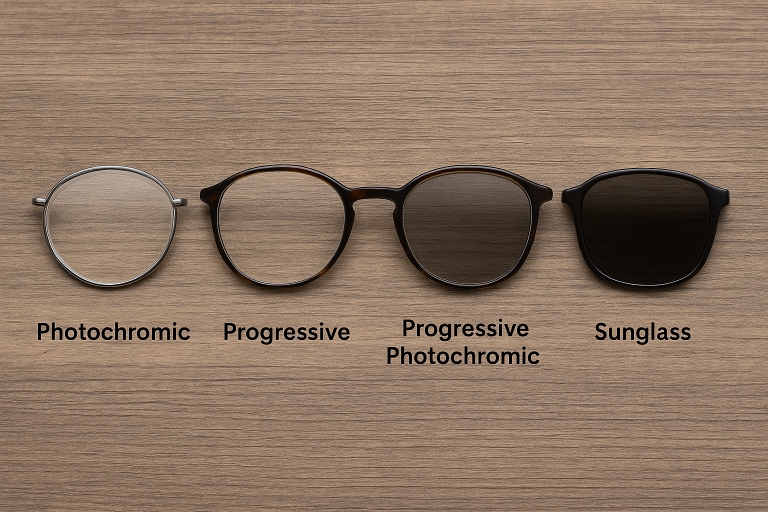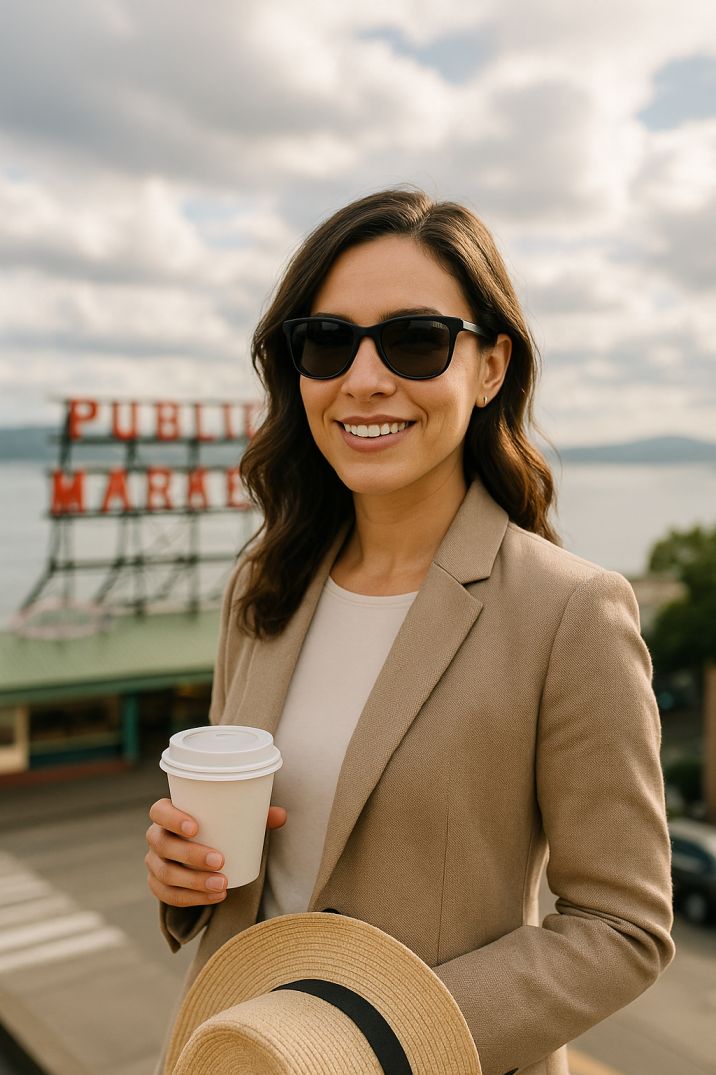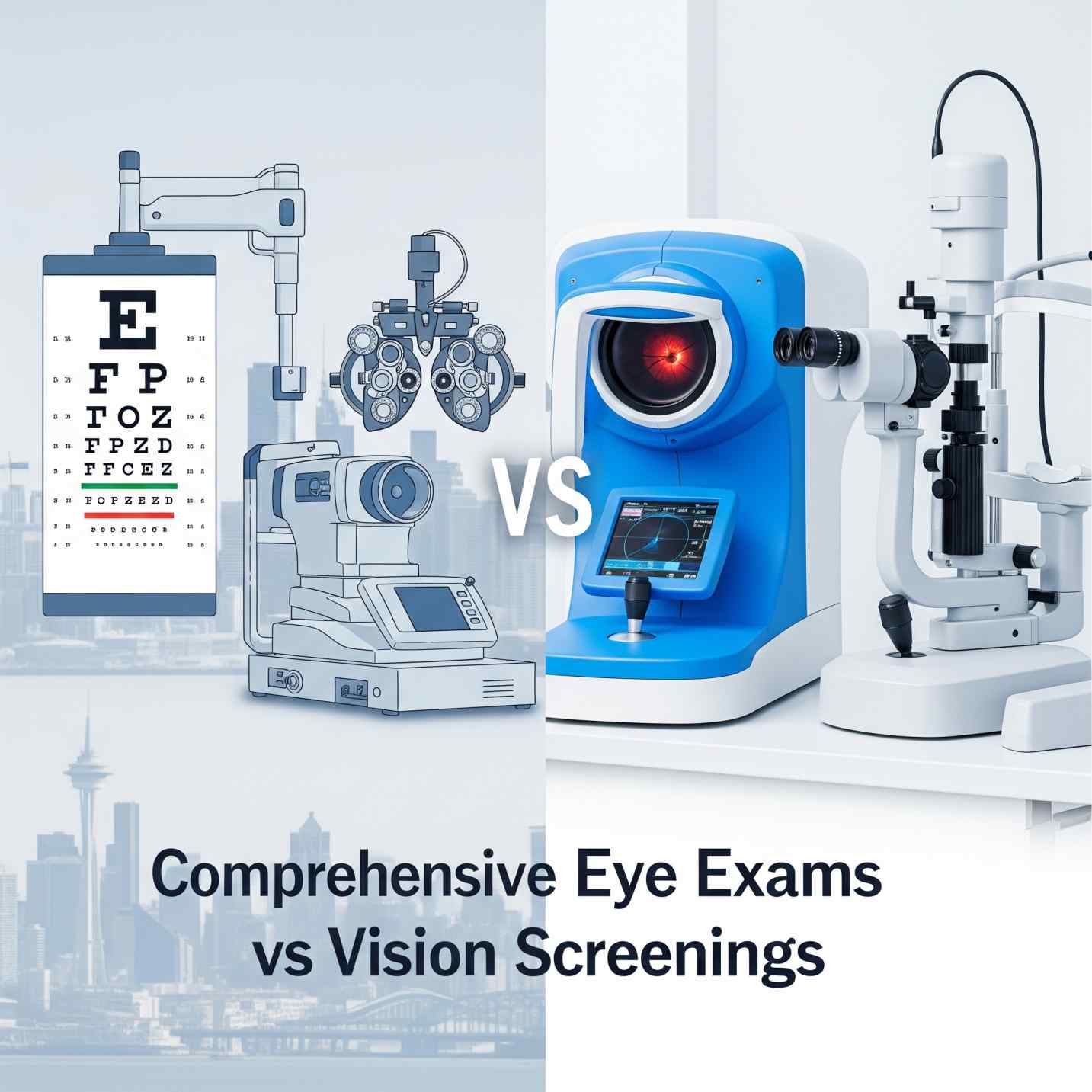Transition Lenses Explained for Seattle Lifestyles
Transition lenses offer one-pair convenience but have drawbacks. Discover if they suit your lifestyle, driving needs, or outdoor activities in this quick guide.
What Are Photochromic (Transition) Lenses?
Transition glasses lenses (technically called photochromic lenses) are light-adaptive lenses that automatically darken outdoors in sunlight and clear indoors. This innovative technology eliminates the need for separate prescription sunglasses – perfect for Seattleites navigating bright days at Green Lake or exploring Capitol Hill’s vibrant streets.
Why Market Optical Recommends Them
At Market Optical in downtown Seattle’s Pike Place Market area, our certified opticians frequently recommend photochromic lenses.
Senior Optician Dorey emphasizes: “Photochromic lenses are a game-changer for our variable Pacific Northwest weather – a true ‘one-and-done’ vision solution.”
Clearing Up Common Confusion
Many patients confuse “Transitions®” (a leading photochromic brand) with progressive lenses. Key differences:
-
Progressives: Multifocal lenses correcting presbyopia (age-related near vision loss starting around 40)
-
Photochromic: Light-adaptive technology for all lighting conditions
The Perfect Seattle Combination
Crucially, photochromic technology combines with progressive lenses. This dual solution is ideal for Seattle’s active 40+ community, providing:
- A clear vision for reading and screens
- Adaptive sun protection outdoors
- Single-pair convenience
Should You Choose Transition Lenses? Insights from a Seattle Optometrist
Dr. Mark Cannon, a Seattle-based optometrist at Cannon EyeCare, regularly addresses this question. Here’s his balanced analysis:
Advantages of Transition Lenses
-
Glare Reduction: Ideal for outdoor activities in changing light, like sunny days at Alki Beach or overcast walks in Discovery Park.
-
Convenience: Eliminates switching between glasses and sunglasses—perfect for Seattle’s unpredictable weather during all-day wear.
-
Full UV Protection: Blocks 100% of harmful UV rays, essential for hikes at Mount Rainier or waterfront strolls.
-
Active Lifestyle Fit: Seamless for cycling the Burke-Gilman Trail or jogging near Lake Washington without interrupting your flow.
Limitations to Consider
-
Indoor Transition Delay: Takes 2–5 minutes to clear after entering buildings (notable during downtown Seattle appointments).
-
Reduced Driving Utility: Car windshields block UV light, leaving lenses mostly clear on I-5 or 520 Bridge commutes (prescription sunglasses outperform here).
-
Performance Gap: Less dark and slower to adapt than dedicated sunglasses in the intense sun (e.g., sailing on Puget Sound).
Top Frame Pick: Rudy Project Rydon
The Rudy Project Rydon frames (current retail: $270) offer versatile prescription compatibility:
-
Mild Prescriptions: Stock lenses accommodate lower vision corrections
-
Stronger Prescriptions: Pair with Rydon Optical Docks ($80) for custom ophthalmic lenses (note: lens costs exceed $80)
Do Transition Lenses Block UV Light?
Absolutely. Transition lenses block 100% of harmful UV radiation—essential for protecting your eyes during Seattle outdoor activities like Mount Rainier hikes or Alki Beach walks.
While matching traditional sunglasses in UV defense, their everyday design differs: Most lack wraparound coverage, allowing peripheral glare during bright days on Lake Washington or downtown’s reflective surfaces.
This side-light exposure can impact comfort and long-term ocular safety.
Why UV Protection Matters in Seattle
Prolonged UV exposure damages eye structures, increasing risks to the cornea, lens (cataract development), and retina. For Seattleites with high prescriptions (+7 diopters or more), transition lenses solve a critical challenge:
-
High-index lenses (minimizing “Coke-bottle” thickness) rarely come in tinted sunglass formats
-
Photochromic technology works seamlessly with 1.74 high-index materials
This provides a practical solution for kayaking on Lake Union or exploring Ballard Locks without contacts.
Clinic Recommendation
At our Seattle eye care clinic, we frequently recommend photochromic lenses to:
-
Tech professionals working near glare-prone windows
-
Cyclists navigating Burke-Gilman Trail
-
Outdoor enthusiasts prioritizing eye health
What’s the difference between Transitions/Photochromics and Progressives?
-
Transitions® (Photochromic):
-
Light-reactive: Clear indoors (Pike Place Market shops) → tinted outdoors (Green Lake).
-
Blocks UV rays for activities like hiking Rattlesnake Ridge.
-
-
Progressives:
-
Multifocal: Corrects distance (driving I-5), intermediate (screens in South Lake Union), and near vision (reading at Elliott Bay Book Company).
-
-
Combo Option:
-
Hybrid lenses merge both technologies—clear for indoor meetings, tinted for Fremont walks, and multifocal for seamless focus shifts.
-
Are transitions good for driving?
They don’t darken much in the car because your windows and moonroof block UV light. Most patients would prefer dedicated sunglasses (or a clip-ons) over photochromic lenses.
Would Transition Glasses work well for cycling and running?
Are Transition Glasses Ideal for Cycling and Running in Seattle?
Absolutely! Outdoor sports like cycling the Burke-Gilman Trail or trail running in Discovery Park are where photochromic lenses shine. Seattle’s ever-changing light—from shaded paths in Seward Park to sudden sunbreaks on Mount Si—demands adaptive eyewear. Transition lenses automatically adjust from clear to tinted, eliminating the hassle of swapping glasses mid-activity.
Why Seattle Athletes Love Them:
-
Rain or Shine: Perfect for misty morning jogs around Green Lake or sunny afternoon bike rides along Lake Washington Boulevard.
-
UV Protection: Blocks 100% harmful rays during prolonged exposure, whether you’re climbing Tiger Mountain or kayaking Elliott Bay.
-
No Lens Swaps: Maintain focus during transitions from forested trails (like Cougar Mountain) to open spaces like Gas Works Park.
Cost and Value: Are Transition Lenses Worth the Investment for Seattleites?
Transition lenses typically cost 100−250 more than standard lenses at Seattle optical shops—but consider the math. Buying separate prescription glasses and sunglasses often exceeds $500, especially with high-index lenses for strong prescriptions (+7 diopters). At Market Optical in downtown Seattle, many patients use FSA/HSA funds to offset costs.
Why Seattleites Save Long-Term:
-
One Pair, Multiple Environments: Ideal for shifting from Amazon meetings in South Lake Union to sunny walks at Kerry Park.
-
UV Protection Built-In: Avoid buying separate sunglasses—critical for hikers tackling Mount Si or sailors on Puget Sound.
-
High-Index Solutions: Seattle opticians like Dorey at Market Optical pair transitions with ultra-thin 1.74 lenses, avoiding ‘Coke-bottle’ sunglass tints.
Caring for Your Transition Lenses
Transition lenses thrive with proper care—here’s how to protect your investment in Seattle’s elements:
Cleaning:
-
Use microfiber cloths (provided free at Market Optical) to prevent scratches.
-
Avoid Windex; opt for lens-safe sprays. Pro tip: Carry a travel kit for hikes in Discovery Park or kayaking on Lake Union.
Storage:
-
Keep lenses dry in Seattle’s drizzle. Store in a case when not worn—never leave them in hot cars (yes, even here!).
Activity-Specific Care:
-
Post-beach rinse: After Alki Beach outings, gently rinse salt spray with fresh water.
-
Trail maintenance: Wipe dust after hiking Rattlesnake Ledge with a lens brush.
How Long Do Transition Lenses Last?
Most transition lenses last 2-3 years, but Seattle’s moody climate can accelerate wear:
Weather Factors:
-
Rain & Humidity: Frequent lens wiping can thin coatings.
-
Limited UV Exposure: Cloudy days mean slower darkening over time.
FAQs
-
Who should consider transition lenses in Seattle?
Active Seattleites who cycle (Burke-Gilman Trail), hike (Mount Rainier), or juggle indoor/outdoor tasks (Pike Place Market workers). Ideal for those needing UV protection without carrying multiple pairs.
-
What makes transition lenses ideal for Seattle weather?
-
Why don’t transition lenses darken in cars?
-
How quickly do transition lenses adjust to light changes?
-
Will transition lenses work on cloudy Seattle days?
-
Are transition lenses more expensive than regular prescription glasses?
-
Can transition lenses handle strong prescriptions common?
-
What are the best alternatives to transition lenses for driving?
-
Why choose transition lenses over regular sunglasses in Seattle?
-
Can transition lenses be combined with progressive lenses?
-
How should I care for transition lenses in Seattle’s rain?
-
How long do transition lenses take to change color?
-
Do transition lenses come in different colors or styles?
-
Do transition lenses work indoors?



